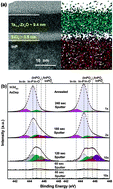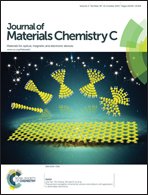The impact of atomic layer deposited SiO2 passivation for high-k Ta1−xZrxO on the InP substrate†
Abstract
Metal–oxide-semiconductor (MOS) capacitors with an amorphous Ta1−xZrxO composite gate dielectric film and a SiO2 passivation layer were fabricated on an indium phosphide (InP) substrate. To investigate the impact of the passivation layer, the interfacial chemical, physical and electrical properties of the Ta1−xZrxO/InP and Ta1−xZrxO/SiO2/InP MOS structures were studied in detail. Electrical conductivity measurements combined with chemical bonding analysis using X-ray photoelectron spectroscopy (XPS) and electron dispersive spectroscopy (EDS) were conducted in order to evaluate the suitability of a Ta1−xZrxO alloy as a gate dielectric film for an InP substrate. XPS results showed that the Ta1−xZrxO film retained its insulating characteristics and was thermally stable even after annealing at 500 °C. However, Fermi-level pinning and significant diffusion of indium through the Ta1−xZrxO were observed. The diffusion of In was remarkably reduced after introducing the SiO2 passivation layer, which resulted in an overall reduction in interfacial layer thickness. Parallel conductance contour measurements showed that the SiO2 passivation layer resulted in unpinning of the Fermi-level. The introduction of a SiO2 passivation layer with the Ta1−xZrxO composite gate dielectric film was found to provide remarkably improved dielectric performance, which was mainly attributed to reduced In diffusion and the passivation of interfacial and bulk dielectric defects.


 Please wait while we load your content...
Please wait while we load your content...